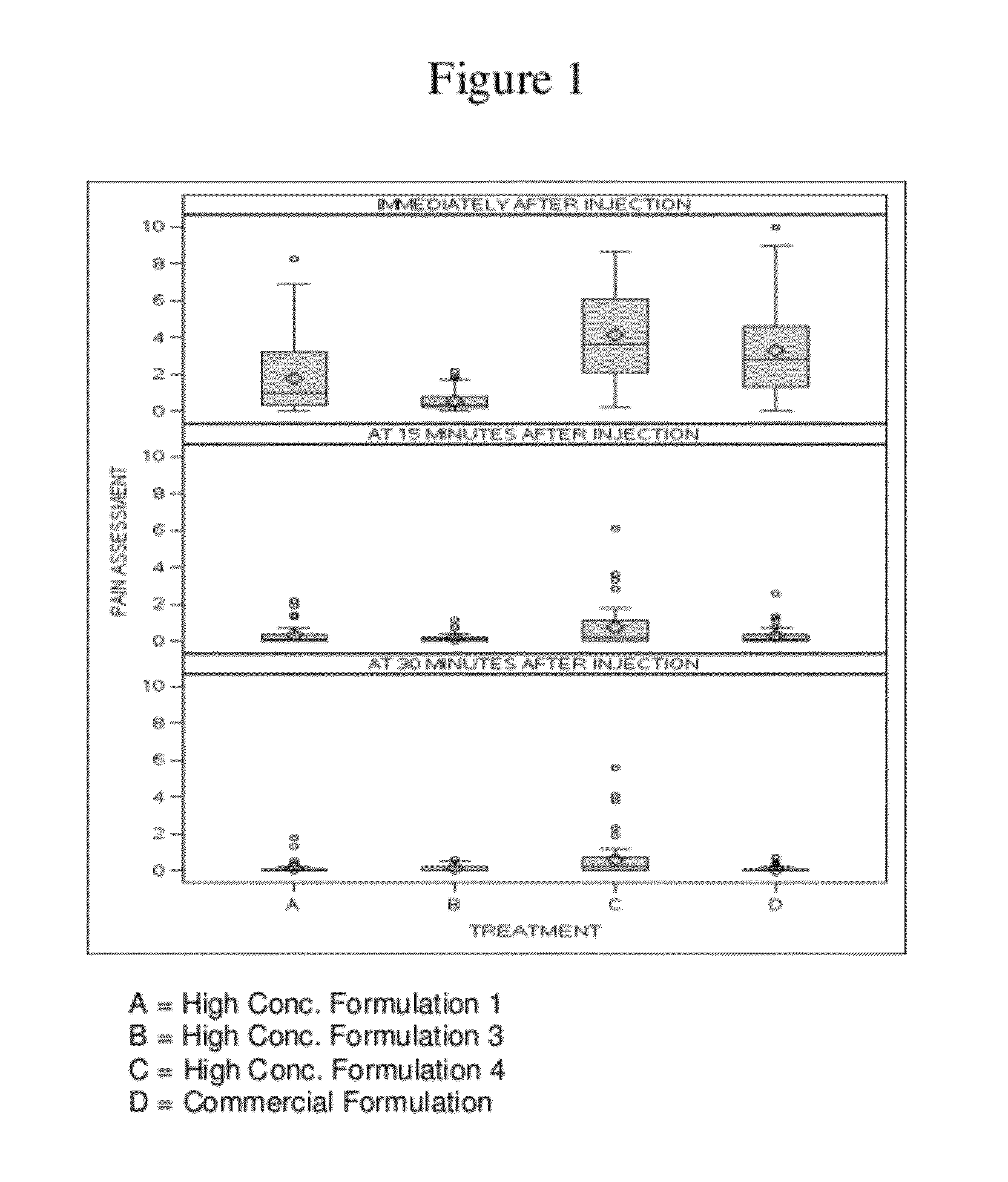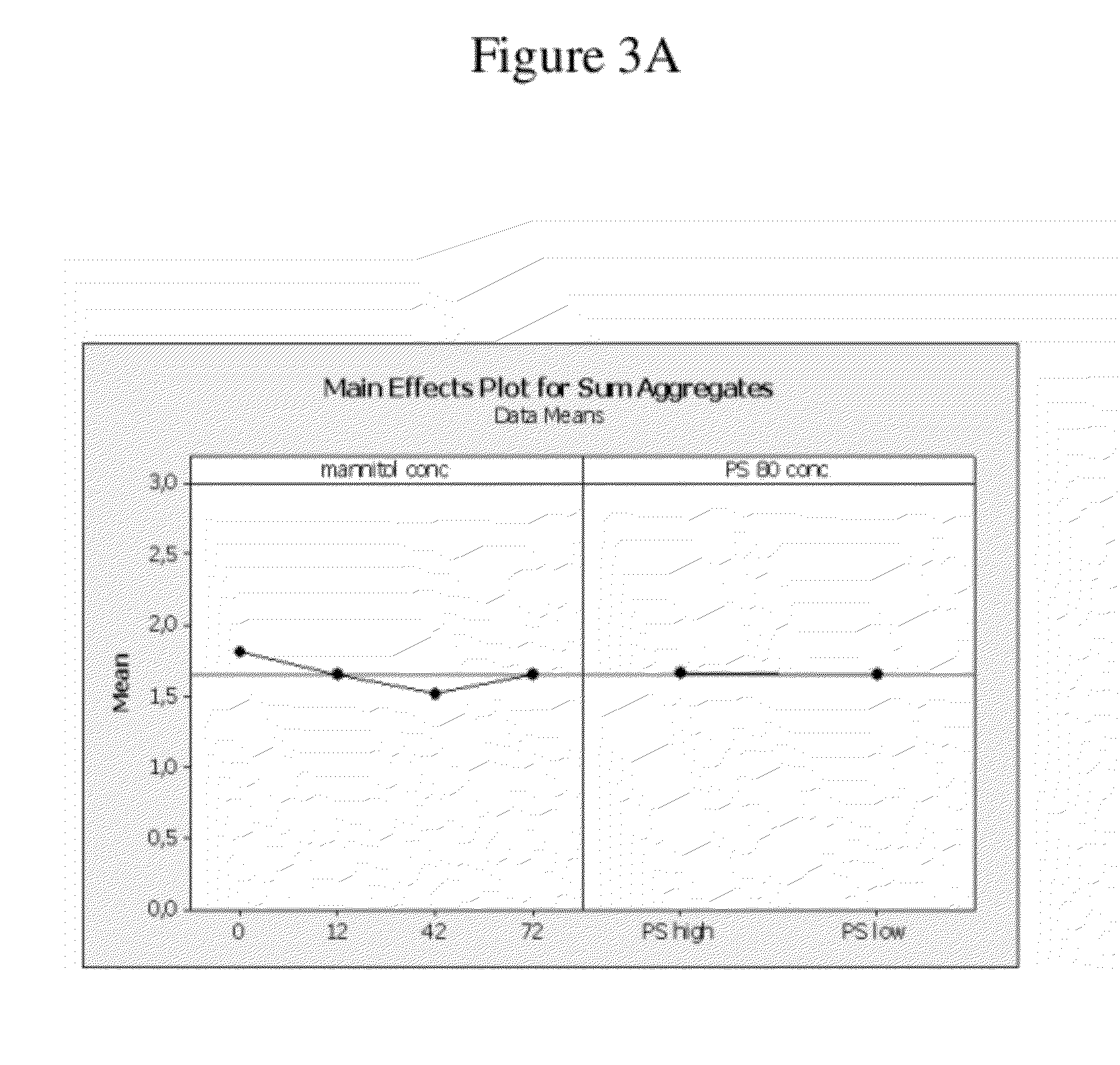HIGH CONCENTRATION ANTI-TNFalpha ANTIBODY LIQUID FORMULATIONS
a high-concentration, anti-tnfalpha technology, applied in the direction of antibody medical ingredients, drug compositions, peptides, etc., can solve the problems of increasing the risk of adverse events in patients, reducing the potency of the protein, and reducing the bioavailability of therapeutic proteins, so as to improve the bioavailability and reduce pain.
- Summary
- Abstract
- Description
- Claims
- Application Information
AI Technical Summary
Benefits of technology
Problems solved by technology
Method used
Image
Examples
example 1
High Concentration Anti-TNFα Antibody Formulation Reduces Injection Pain
[0342]There have been reports of pain associated with the subcutaneous administration of a human anti-TNFα antibody, e.g., adalimumab. In placebo-controlled trials, 20% of patients treated with adalimumab developed injection site reactions (erythema and / or itching, haemorrhage, pain or swelling), compared to 14% of patients receiving placebo. Most injection site reactions are mild and do not generally necessitate drug discontinuation.
[0343]There are two main components of the injection pain associated with adalimumab: the pain associated with the needle stick, and the pain associated with the injection of drug into the tissue. The injection-related pain may be related to the Adalimumab formulation and / or to the volume of medication. The following study examined whether various formulations have an impact on injection pain following subcutaneous delivery of adalimumab.
Materials and Methods
Study Design
[0344]The pr...
example 2
High Concentration Anti-TNFA Antibody Formulations Increase Bioavailability in Humans
[0398]The following example describes a Phase 1, single-blind, single-dose, parallel-group design, randomized study in healthy volunteers (same study described above in Example 1). The primary objectives of this study were to compare injection-related pain of three high concentration (100 mg / mL) adalimumab formulations in the Physiolis PFS with the current (50 mg / mL) adalimumab (Humira) formulation in the current PFS (see Example 1), and to assess the bioavailability of three high concentration (100 mg / mL) adalimumab formulations in comparison to the current commercial (50 mg / mL) adalimumab (Humira) formulation. The secondary objective of this study was to assess the safety and tolerability of all four adalimumab formulations.
Study Design
[0399]Two hundred healthy volunteers were enrolled in this study (Table 10). Pain assessment data were obtained from all 200 subjects. Adalimumab pharmacokinetics w...
example 3
High Concentration Anti-TNFA Antibody Formulation Increase Bioavailability in Pre-Clinical Model
[0409]The objective of the following study was to evaluate the pharmacokinetic profiles of adalimumab formulation F4 in contrast to the adalimumab commercial formulation (see Table 7 above for a description of the formulation).
[0410]The pharmacokinetic profiles of HUMIRA (Adalimumab) were studied in male and female Beagle dogs (2 / sex / s.c. administration and 2 males / i.v. administration, Marshall Bio Resources USA, Inc., North Rose, N.Y. 14516) after a single subcutaneous (s.c.) injection of the HUMIRA commercial formulation (adalimumab) and a HUMIRA test formulation corresponding to formulation F4 of the previous examples (adalimumab), as well as an intravenous (i.v.) injection of the HUMIRA commercial formulation as a control. The administered dose was 40 mg / dog (at 100 mg / mL for F4 and 50 mg / mL of the commercial formulation).
[0411]For the determination of Adalimumab serum exposure levels...
PUM
| Property | Measurement | Unit |
|---|---|---|
| concentration | aaaaa | aaaaa |
| concentration | aaaaa | aaaaa |
| hydrodynamic diameter | aaaaa | aaaaa |
Abstract
Description
Claims
Application Information
 Login to View More
Login to View More - R&D
- Intellectual Property
- Life Sciences
- Materials
- Tech Scout
- Unparalleled Data Quality
- Higher Quality Content
- 60% Fewer Hallucinations
Browse by: Latest US Patents, China's latest patents, Technical Efficacy Thesaurus, Application Domain, Technology Topic, Popular Technical Reports.
© 2025 PatSnap. All rights reserved.Legal|Privacy policy|Modern Slavery Act Transparency Statement|Sitemap|About US| Contact US: help@patsnap.com



